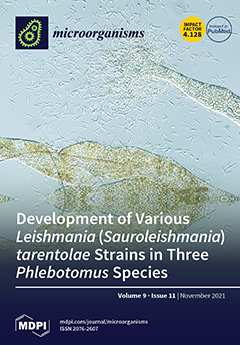Cryptosporidium is an apicomplexan parasitic protist, which infects a wide range of hosts, causing cryptosporidiosis disease. In farms, the incidence of this disease is high in animals such as cows, leading to extensive economic loss in the livestock industry. Infected cows may also act as a major reservoir of
Cryptosporidium spp., in particular
C. parvum, the most common cause of cryptosporidiosis in these animals. This poses a risk to the trading of livestock, to other farms via breeding centres, and to human health. This study is a part of a global project aimed at strategies to tackle cryptosporidiosis. To reach this target, it was essential to determine whether prevalence was dependent on the studied countries or if the issue was borderless. Indeed,
C. parvum occurrence was assessed across dairy farms in certain regions of Belgium, France, and the Netherlands. At the same time, the animal-to-animal transmission of the circulating
C. parvum subtypes was studied. To accomplish this, we analysed 1084 faecal samples, corresponding to 57 dairy farms from all three countries. To this end,
18S rRNA and
gp60 genes fragments were amplified, followed by DNA sequencing, which was subsequently used for detection and subtyping
C. parvum. Bioinformatic and phylogenetic methods were integrated to analyse and characterise the obtained DNA sequences. Our results show 25.7%, 24.9% and 20.8% prevalence of
Cryptosporidium spp. in Belgium, France, and the Netherlands respectively. Overall, 93% of the farms were
Cryptosporidium positive. The
gp60 subtyping demonstrated a significant number of the
C. parvum positives belonged to the IIa allelic family, which has been also identified in humans. Therefore, this study highlights how prevalent
C. parvum is in dairy farms and further suggests cattle as a possible carrier of zoonotic
C. parvum subtypes, which could pose a threat to human health.
Full article






